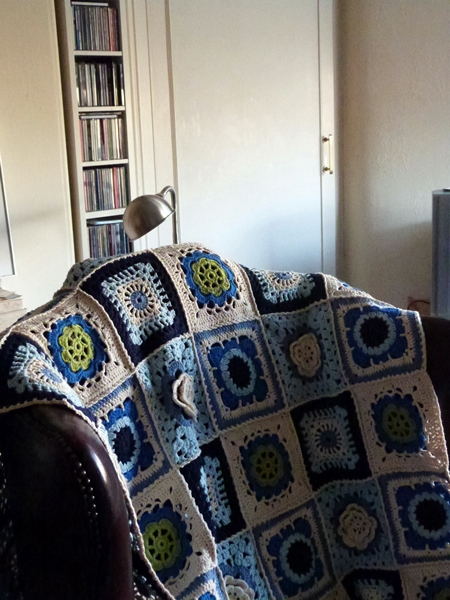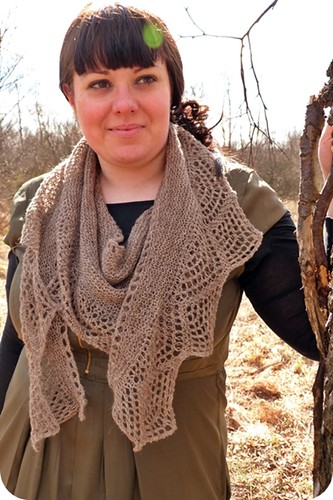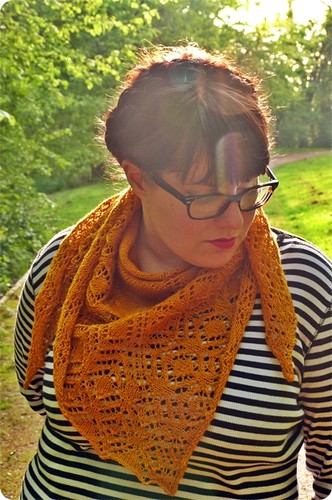I have been collaborating with my good friend, the marvellous Susan Crawford, and Noblesse Oblige is my contribution to her "Knits in a Cold Climate" collection.

When I was given the design brief by Susan, I knew I wanted to use the wonderful colour range in Susan Crawford Fenella. Inspired by my recent forays into knitting archives, I began sketching Fair Isle bands but it was not until I uncovered a photo of a 1930s knitting pattern that I decided upon the colour scheme. The jumper is charming, but I fell in love with the red/green/yellow motif. Could I use these colours in a more traditional setting?

After several attempts, I hit upon a 1930s inspired hat and scarf using that red/green/yellow combination, but also tempered by a soft porcelain blue and a delightful creamy white. The jaunty beret features two Fair Isle bands that counteract each other to create a sense of dynamism.
The scarf comes in three sizes - you can make it a neckerchief, a small scarf or a full-sized shawl. To optimise knitting pleasure, the scarf does not use Fair Isle bands but features narrow stripes in a colour sequence that calls back to the beret. After much discussion, Susan and I agreed that small, felted pompoms would add a delightful finishing touch.

Naming the pattern was harder. I wanted to use one of Nancy Mitford's book titles, but neither Christmas Pudding nor Pigeon Pie seemed appropriate! Finally, Noblesse Oblige seemed to suggest itself - it is a collection of essays and I rather enjoyed Nancy Mitford's essay on the English language. So, Noblesse Oblige. A lovely hat and scarf set. I hope you will enjoy knitting it.
But let's talk about Nancy Mitford's essay briefly.
Found in Noblesse Oblige, "The English Aristocracy" is her most famous essay. Nancy Mitford had recently read an academic article by a British linguist and was inspired to write her own examination of how the British upper class ("U") and the middle class ("non-U") spoke. The essay is very much of its time - apparently only non-U people would speak of telephones! - but that is also part of its appeal. It is a snapshot of a world in transition where old notions of class and importance are slowly eroding. It is particularly interesting to compare Mitford's essay to Grayson Perry's TV documentaries about Class in Britain. The economic barriers between the classes may have eroded, but cultural markers such as language and taste have not.
"The English Aristocracy" is an early example of what we know today as sociolinguistics. A "sociolect" is a type of language associated with one socioeconomic class, age group or gender. The British 1990s sit-com Keeping Up Appearances uses Mitford's little U vs non-U markers and sociolects to great comic effect. The main protagonist, Hyacinth Bucket, insists her surname is pronounced Bouquet, and she keeps grasping at big, fancy words in her attempt to sound more refined (something Mitford notes is the true mark of a social climber - why use the word "lavatory" when "loo" is perfectly adequate?). The underlying class anxiety so evident in Mitford's 1950s essay is very much visible even forty and fifty years on.
If you have half an hour to spare, I suggest you read Mitford's little essay in Noblesse Oblige - I assure you that you will notice amusing little things about how you and the people around you speak.
Now for the important pattern details: you can buy the pattern from Ravelry here. It is £4 and the pattern uses five shades of Fenella. Susan is planning on offering a kit which you will be able to buy from her shop.
It has been marvellous working with Susan on this pattern - she understands my shorthand descriptions so very, very well and has an incredible eye for details, style, and colour. I also really enjoyed working with Fenella which has a such lovely bounce in its step.

 I have always been drawn to liminal spaces. Places that are thresholds (like beaches, doorways, or bridges). I think it stems from always feeling slightly out of time and place myself. Part of my continual fascination with the Doggerland landscape is that we only know glimpses and we can only see traces. Early pottery in northern Europe can be interpreted as having that liminal quality too - we only find tiny fragments and they speak of a transitional culture moving through an uncertain time and space.
Pottery can seem so straightforward to modern people and we can play with its perceived primitivism in our heads: man reaches down and scoops up a handful of humble soil; with his bare hands, he sculpts a crude looking retainer; the small pot is baked on a fire. The reality is somewhat different as pottery is a sophisticated technology. Still, there is something so very fundamental about the relationship between earth and fire - one that calls for story-telling and myth-making.
I have always been drawn to liminal spaces. Places that are thresholds (like beaches, doorways, or bridges). I think it stems from always feeling slightly out of time and place myself. Part of my continual fascination with the Doggerland landscape is that we only know glimpses and we can only see traces. Early pottery in northern Europe can be interpreted as having that liminal quality too - we only find tiny fragments and they speak of a transitional culture moving through an uncertain time and space.
Pottery can seem so straightforward to modern people and we can play with its perceived primitivism in our heads: man reaches down and scoops up a handful of humble soil; with his bare hands, he sculpts a crude looking retainer; the small pot is baked on a fire. The reality is somewhat different as pottery is a sophisticated technology. Still, there is something so very fundamental about the relationship between earth and fire - one that calls for story-telling and myth-making. I often get asked how I ended up doing what I do for a living. Now that is a very long story - so I often just explain that I'm the fifth generation of very crafty, creative women. It's a simplification but it is also the truth. In 2011
I often get asked how I ended up doing what I do for a living. Now that is a very long story - so I often just explain that I'm the fifth generation of very crafty, creative women. It's a simplification but it is also the truth. In 2011 


